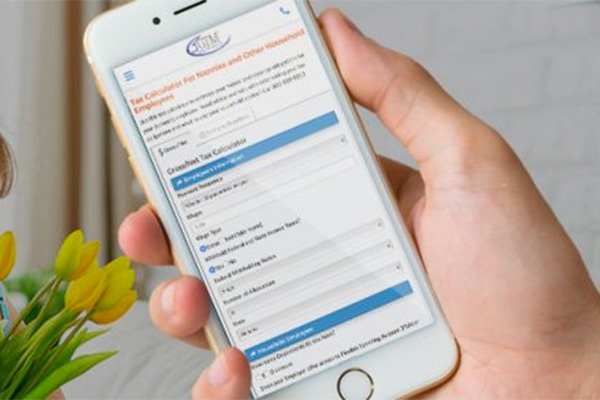How to Pay Your Nanny Taxes in 2023
Everything You Need to Know about Paying Nanny Taxes
Payroll. Tax. Insurance. Compliance. It’s time-consuming and may seem overwhelming. The IRS estimates that it can take a household employer 60 hours each year to comply with all federal and state tax laws and get your nanny taxes done right.
That’s why we put together this Nanny Tax Guide to help you every step of the way.
Download The Complete Guide to Household Payroll
Get all of this nanny tax information in our complimentary household payroll guide. Learn everything you need to know about paying your employees legally and filing your taxes the right way.
What is the Nanny Tax?
Nanny taxes are the employment taxes for those who hire household workers like nannies, housekeepers, and senior caregivers and pay them more than the nanny tax threshold. For 2024, this threshold is $2,700 (for wages paid in 2023, the threshold is $2,600). Once that limit has been met, employer and employee shares of Social Security and Medicare taxes must be remitted. If an employee is paid $1,000 or more in a calendar quarter, then federal unemployment taxes are due. State unemployment taxes may also be required.
Understanding the Nanny Tax
Why do we have the nanny tax? Those hired to work in someone’s home are considered employees (not independent contractors) and the family an employer. This is no different than a business hiring someone to work in an office or retail store. The same employment taxes – like Social Security, Medicare, and unemployment – apply to household employment. Also, nanny taxes aren’t just for nannies but apply to anyone who works in a home such as housekeepers, senior caregivers, chefs, chauffeurs, butlers, estate managers, estate staff, and others. Employees could also include after-school nannies, tutors, and seasonal or temporary child caregivers.
Contents:
- Determining if You Need to Pay Nanny Taxes
- Filing to Become an Employer
- Determining Your Employee Work Eligibility
- Employee Nanny Tax Responsibilities
- Calculating What You Owe in Nanny Taxes
- Minimizing Your Nanny Tax Payments
- Reporting and Filing Your Nanny Taxes
- Beyond Nanny Taxes: Other Employer Responsibilities
Watch Our Video: Your Household Payroll and Nanny Taxes Made Easy
1) Determining If You Need to Pay Nanny Taxes
If a family employs an individual to perform duties in or around their home and has the right to control when, where, how, or by whom the work should be performed, then that person can be considered a household employee.
The IRS defines a household employer as someone who pays an individual $2,700 or more (for 2023 the threshold was $2,600) in a calendar year to work in their home.
If you’re considered a household employer by the IRS, then you need to pay Social Security and Medicare taxes on your employee. Your share is 7.65 percent of their wages. Your employee’s share is also 7.65 percent, which you can choose to pay yourself or withhold from their wages.
Also, if you pay a household employee $1,000 or more in any calendar quarter, you must pay federal unemployment tax (six percent of wages) on up to $7,000 in wages. You may also owe state unemployment tax (about two to five percent in most states).
You do not need to pay Social Security and Medicare taxes on wages you paid to your spouse, children under 21 years of age, parent, or any employee under the age of 18. For unemployment taxes, do not count wages paid to your spouse, children under 21 years of age, or parent.
Related Video
Is your Nanny an Employee or an Independent Contractor?
With an employee, the employer pays taxes as well as the worker. An independent contractor pays both the employee and employer portions of the tax responsibility.
Misclassification is considered tax evasion and the Department of Labor and IRS have increased their enforcement. The IRS classifies a nanny as an employee nearly all the time.
2) Filing to Become an Employer
Becoming a household employer comes with its fair share of paperwork. There are a number of federal forms that need to be completed before your employee starts work.
Forms You’ll Need:
- Form SS-4: Application for Employer Identification Number
Household employers must have an employer identification number (EIN). This gives you a specific tax number, like a Social Security number for employees, for dealing with the IRS and other agencies. Download Form SS-4. - Form W-4: Employee’s Withholding Allowance Certificate
If you and your employee agree to withhold federal income tax, this form documents how much income tax is to be withheld from your employee’s pay. Download Form W-4. - Form I-9: Employment Eligibility Verification
Household employers must obtain a completed I-9 for every employee hired. This is used to verify the identity and employment eligibility of your domestic workers. Keep this form on file with copies of the documentation your employee provided for employment eligibility. Download Form I-9. - Form W-10: Dependent Care Provider’s Identification and Certification
This form collects information about your household employee if you plan to claim a credit for child and/or dependent care expenses on your personal tax filing or if you receive benefits under your employer’s dependent care or flexible spending plan. Download Form W-10.
State Requirements
Individual states may also have requirements for household employers. Contact your state’s department of taxation or revenue to understand your responsibilities. These could include:
- Unemployment Identification Number
You are required to obtain an unemployment identification number with the state where the physical work will be performed. This is needed to pay state unemployment taxes on a quarterly basis. - Withholding Certificate
If you and your employee decide to withhold state income taxes, then you’ll need to complete a withholding certificate through the appropriate state agency. You’ll receive an ID number, coupon booklet, and instructions on how to submit withholding taxes. - New Hire Report
You must register any new employee with the state in a certain time frame of the hire date. The report asks for basic identification information for each new employee.
3) Determining Your Employee’s Work Eligibility
Your employee should have a Social Security Number. If they are not a U.S. citizen, they must be authorized to work in the country by the Department of Homeland Security. Never assume your employee has a Social Security Number and be sure to verify all numbers with the Social Security Administration.
4) Employee Nanny Tax Responsibilities
At the start of their employment, inform your nanny of her payroll tax obligations. This way there are no surprises on the first payday. Household employees are liable for four key taxes:
- Social Security (6.2 percent)
- Medicare (1.45 percent)
- Federal income tax
- State and local income taxes (if applicable)
Federal and state income taxes are not required to be withheld unless agreed upon by you and the employee. However, withholding income taxes on a regular basis will benefit your employee. This way, their income tax obligations are distributed throughout the year rather than paying a lump sum at the end of the tax year. It also helps document their employment history as well as ensure both you and your employee are compliant with the law.
The Benefits for You of Paying Nanny Taxes
- Attract Higher Quality Employees
- Work with a Happier Employee
- Avoid State and Federal Fines and Penalties
- Reduce the Risk of an Audit
- Take Advantage of Tax Savings
- Enjoy Peace of Mind
The Benefits for Your Employee of Being Paid “On the Books”
- Verifiable Income
- Legal Employment History
- Unemployment Benefits
- Social Security and Medicare Benefits
- Workers’ Compensation Benefits
5) Calculating What You Owe in Nanny Taxes
Using a nanny tax calculator will help you determine your employee’s net pay (often referred to as “take-home pay”) as well as your total financial responsibility (employee pay plus employer taxes).
Here are 5 helpful ways to use a nanny tax calculator.
Example
Let’s say you live in New York State and would like to pay a nanny $20/hour for 40 hours of work each week (or $800 in gross pay per week) to look after one child. In this example, your employee’s withholding status is “single” and doesn’t have a second job. There is no overtime involved.
Employee Pay
Each pay period, your employee would owe:
- Federal income tax: $57.85
- Social Security: $49.60
- Medicare: $11.60
- State income tax: $1.80
- Total tax responsibility: $120.85
- Net pay: $679.15 ($800 gross pay – $120.85 taxes)
Employer Taxes
On top of your employee’s pay, you would owe:
- Federal unemployment: $4.80
- Social Security: $49.60
- Medicare: $11.60
- State unemployment: $21.60
- Total tax responsibility: $87.60
Each pay period, your responsibility is $887.60 (employee pay of $800 plus your tax obligation). For the calendar year, your tax responsibility is $3,440.40. This can be reduced significantly through your employer’s Dependent Care Flexible Spending Account (FSA) and/or the Child & Dependent Care Tax Credit.
6) Minimizing Your Nanny Tax Payments
Dependent Care Assistance Program/Flexible Spending Account
You can reimburse your dependent care expenses (such as your employer taxes or a portion of your nanny’s pay) with pre-tax funds through your employer-sponsored Dependent Care Assistance Program (DCAP) or Flexible Spending Account (FSA).
If your employer offers a plan, you are allowed to set aside up to $5,000 per year of tax-free money. This helps reduce your taxable income and, depending on your marginal tax rate, can save you up to $2,300 per year. Check with your company’s human resources department to see if there is a program available to you.
Child and Dependent Care Tax Credit
You can take advantage of the Child and Dependent Care Tax Credit (Form 2441) – regardless of your income level – on your personal income tax return. You can claim up to $3,000 of qualifying child care expenses (such as your nanny’s pay) paid in a year for one qualifying individual or $6,000 for two or more qualifying individuals. The 20 percent credit on these expenses can save you $600 for families with one child or $1,200 if you have two or more children.
Get Help with Nanny Taxes
GTM can manage your nanny taxes and payroll with:
- Automatic payroll processing
- 100% guaranteed on-time tax filings
- Workers’ compensation insurance
- Online, secure access to your data
- Compliance with tax and labor laws
- Additional insurance options
- Concierge-level support
Free Consultation!
To get your free, no-obligation consultation with a household employment expert, call us at (800) 929-9213, Monday through Friday, 8:30 am – 8 pm Eastern.
7) Reporting and Filing Your Nanny Taxes
Federal Taxes: Quarterly Filings
You can pay estimated taxes on a quarterly schedule. This can help alleviate your tax burden at the end of the year. To file quarterly, you will need to submit Form 1040-ES (Estimated Tax for Individuals), which estimates employee federal income tax, employer and employee Social Security and Medicare taxes, and the employer federal unemployment tax.
- Quarterly filings are due on April 15, June 15, September 15, and January 15. The deadline may be later if the date falls on a Sunday or holiday.
- Another option, if not paying quarterly, is to have additional federal income tax withheld from your own salary. This may help avoid owing a large amount on your personal federal tax return.
Federal Taxes: Annual Filings
- Even if filing quarterly, you must report all federal taxes by submitting Schedule H (Household Employment Taxes) with your personal tax return. Schedule H is an annual reconciliation form that is used to report wages paid to your employee throughout the year.
- You must also provide your employees with Form W-2 (Wage and Tax Statement) on or before January 31. This provides a breakdown of all withholding and income throughout the previous calendar year and helps your employee submit their individual income tax returns.
- By January 31, you must also file your (employer’s) copy of an employee’s W-2 and Form W-3 (Transmittal of Wage and Tax Statements) to the Social Security Administration. The W-3 is a reconciliation of all W-2s for each employee, even if you have only one domestic worker.
Haven’t been keeping up with your household employment taxes? Here’s how to get caught up and handle your year-end nanny taxes in seven steps.
State Taxes
Most states require a quarterly filing of state taxes. However, state tax quarters do not align with federal tax quarters. States require taxes to be submitted every three months, typically one month after the quarter ends. After you are registered as an employer with your state, you’ll receive blank quarterly forms with instructions on how and when to file. Many states now require you to remit your taxes electronically and may penalize you if you pay by check.
8) Beyond Nanny Taxes: Other Employer Responsibilities
You have other responsibilities beyond payroll and tax obligations.
- Many states require household employers to carry a workers’ compensation insurance policy.
- Several states have tax, wage, and labor laws that specifically pertain to household employees called a Domestic Workers’ Bill of Rights.
- Nannies must be paid at least the federal minimum wage or your state or local minimum wage, whichever is highest.
- Hours worked over 40 in a week need to be paid at no less than time and a half.
- Some states require you to withhold additional taxes for disability insurance.
- Sleeping time laws may impact live-in nannies and senior caregivers and employees working overnights or long shifts.
- Make any required contributions and/or withholdings for your state’s paid family and/or medical leave laws.
Talk to an Expert
Questions about nanny tax or payroll? Our household employment experts can help. Talk to an expert today or schedule a complimentary, no-obligation phone consultation.
Schedule a time to talk and we'll call you.
Chat with Us
Chat with an expert during business hours.
Schedule a time to talk and we'll call you.
Chat with Us
Chat with an expert during business hours.




